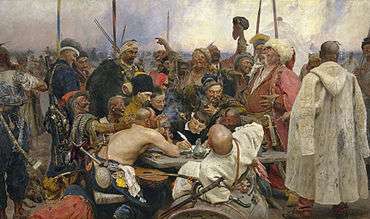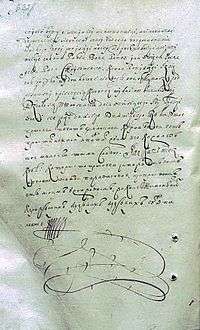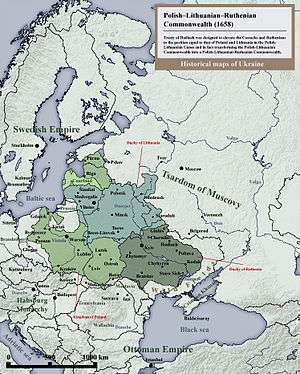Treaty of Hadiach
| Part of a series on |
| Cossacks |
|---|
 |
| Cossack hosts |
| Other groups |
| History |
| Cossacks |
| Cossack terms |
The Treaty of Hadiach (Polish: ugoda hadziacka; Ukrainian: гадяцький договір) was a treaty signed on 16 September 1658 in Hadiach (Hadziacz, Hadiacz, Гадяч) between representatives of the Polish–Lithuanian Commonwealth (represented by S. Bieniewski and K. Jewłaszewski) and Ukrainian Cossacks (represented by Hetman Ivan Vyhovsky and starshina (sztarszyna, the elders) Yuri Nemyrych, architect of the treaty, and Pavlo Teteria). It was designed to elevate the Cossacks and Ruthenians to the position equal to that of Poland and Lithuania in the Polish–Lithuanian union and in fact transforming the Polish–Lithuanian Commonwealth into a Polish–Lithuanian–Ruthenian Commonwealth (Rzeczpospolita Trojga Narodów, "Commonwealth of Three Nations").
Features


The specific features of the Treaty of Hadiach were:
- creation of the Duchy of Ruthenia (Polish: Księstwo Ruskie) from Chernigov Voivodeship, Kiev Voivodeship and Bratslav Voivodeship (The Cossack negotiators had originally demanded that Ruthenian Voivodeship, Volhynian Voivodship, Belz Voivodeship, and Podolian Voivodeship be included as well), which would be governed by a Cossack hetman, elected for life from among four candidates presented by the Cossacks and confirmed by the King of Poland;
- creation of parallel Ruthenian offices, tribunal, academy (Kiev's Orthodox Collegium would be raised to the status of an academy; a second Orthodox higher institution of learning would be founded; and as many schools and printing presses "as were necessary" would be established), a judicial system, treasury and mint as existed in Poland and Lithuania (see Offices in the Polish–Lithuanian Commonwealth);
- the Duchy would be connected with the Commonwealth by the common king. There would be only one national parliament (Sejm) and one foreign policy in the Polish–Lithuanian–Ruthenian Commonwealth;
- admission to the Senate of Orthodox ecclesiastic members: the Archbishop (metropolitan) of Kiev and other Orthodox bishops (of Lutsk, Lviv, Przemyśl, Chełm and Mstislav) and elevation of the Orthodox religion and Church to the same level as Catholicism. No Uniate monasteries or churches were to be built in the Duchy - the Union of Brest would be dissolved on the territory of the Ruthenian Duchy;
- ennoblement of Cossack elders (starshyna kozatska). Each year the hetman would recommend to the king 1,000 Cossacks to receive a patent of hereditary nobility, and up to 100 Cossacks in each military regiment could be personally ennobled as well.
- establishment of a Cossack army, in the form of the Cossack register of 30,000. The officers of these forces would be elected by their own members. The Cossacks' own forces would be supplemented by 10,000 regular mercenaries, paid from public taxes. No other Commonwealth troops were to be allowed in Rus' without the consent of the Cossack hetman, except in the event of war, and then they would come under the Cossack hetman's command;
- return of land and property to Commonwealth nobility (szlachta), which had been confiscated by Cossacks after the 1648 Khmelnytsky Uprising;
- a general amnesty for previous crimes would be decreed.
History and importance


Historian Andrew Wilson has called this "one of the great 'What-ifs?' of Ukrainian and East European history", noting that "If it had been successfully implemented, the Commonwealth would finally have become a loose confederation of Poles, Lithuanians and Ruthenians. The missing Ukrainian buffer state would have come into being as the Commonwealth's eastern pillar. Russian expansion might have been checked and Poland spared the agonies of the Partitions or, perhaps just as likely, it might have struggled on longer as the 'Sick man of Europe'" (p. 65).
In spite of considerable Roman Catholic Clergy opposition, the Treaty of Hadiach was approved by Polish king and parliament (Sejm) on 22 May 1659, but with an amended text.[1] The idea of a Ruthenian Duchy within the Commonwealth was completely abandoned.[2] It was a Commonwealth attempt to regain influence over the Ukrainian territories, lost after the series of Cossack uprisings (like the Khmelnytsky Uprising) and growing influence of Muscovy over the Cossacks (like the 1654 Treaty of Pereyaslav).
Hetman Vyhovsky supported the negotiations with the Commonwealth, especially after he suppressed a revolt led by the colonel of Poltava, Martyn Pushkar, and severed relations with Tsardom of Russia for its violations of the Treaty of Pereyaslav of 1654.[3] The Treaty of Hadiach was, however, viewed by many Cossacks as 'too little, too late', and they especially opposed the agreement to return land property to the szlachta. After the 1648 revolt, the Commonwealth was very unpopular with ordinary Cossacks. Rank-and-file Cossacks saw Orthodox Moscow as their natural ally and did not care for alliance with the Commonwealth. Furthermore, Hadiach was too much a deal that merely benefited the elite of the Cossacks—the "starshyna"—who wanted to be recognized as equal to the Polish nobility. Thus, while some Cossacks, among them the hetman Ivan Vyhovsky supported the Commonwealth, many did not, and Cossack unrest continued in Ukraine.[4]
The Commonwealth position was further weakened by a string of losses in the Russo-Polish War (1654–67). The Tsar felt threatened by the Treaty of Hadiach, which weakened his hold on Cossacks. The Russians saw the treaty as an act of war, and even before it was ratified sent an army into Ukraine. Although Polish forces under hetman Stefan Czarniecki dealt defeat to Russian forces at the battle of Polonka, and recaptured Wilno in 1660, lack of other Commonwealth military successes, especially in Ukraine, further undermined Cossack support of the Commonwealth. Vyhovsky's early success at the battle of Konotop in June 1659 was not decisive enough, and was followed by a series of defeats. The Russian garrisons in Ukraine continued to hold out; a Zaporozhian attack on the Crimea forced Vyhovsky's Tatar allies to return home, and unrest broke out in the Poltava region. Finally, several pro-Russian colonels rebelled and accused Vyhovsky of "selling Ukraine out to the Poles."
Unable to continue the war, Vyhovsky resigned in October 1659 and retired to Poland. The situation was further complicated by the Ottoman Empire, which tried to gain control of the disputed region and played all factions against each other. Meanwhile, the Commonwealth was weakened by the rokosz of Jerzy Lubomirski. The treaty was mostly repeated in the 1660 Treaty of Cudnów.
In the end, Russia was victorious, as seen in the 1667 Treaty of Andrusovo and the 1686 Eternal Peace. Ukrainian Cossacks fell under the Russian sphere of influence, with much fewer privileges under the Hetmanate than would have been granted under the treaty of Hadiach. By the end of the 18th century, Cossack political influence has been almost completely destroyed by the Russian Empire.
Second Treaty of Hadiach
In the aftermath of the November Uprising in 1831, there was an attempt to recreate the Treaty of Hadiach, to form a Polish–Lithuanian–Ruthenian Commonwealth to throw off the partitions of Poland. It was then that the coat of arms of the proposed Commonwealth was created. The planned convention in Hadiach was declared illegal by the Russians, who stationed close to 2,000 soldiers there to ensure that no meetings or demonstrations take place and blocked passage through nearby bridges. Despite these precautions, a mass and a celebration involving 15–20,000 people and over 200 priests (both Catholic and Orthodox) took place near Hadiach.
See also
References
- ↑ Rober Paul Magocsi "A History of Ukraine" pp.221-225
- ↑ Т.Г. Таирова-Яковлева Иван Выговский // Единорогъ. Материалы по военной истории Восточной Европы эпохи Средних веков и Раннего Нового времени, вып.1, М., 2009: Под влиянием польской общественности и сильного диктата Ватикана сейм в мае 1659 г. принял Гадячский договор в более чем урезанном виде. Идея Княжества Руського вообще была уничтожена, равно как и положение о сохранении союза с Москвой. Отменялась и ликвидация унии, равно как и целый ряд других позитивных статей.
- ↑ http://www.mfa.gov.ua/rsa/en/20226.htm
- ↑ Dvornik, Francis (1962) The Slavs in European History and Civilization. New Brunswick: Rutgers University Press
- Andrew Wilson, The Ukrainians: Unexpected Nation, New Haven: Yale University Press. 2000, review online
- Paul Robert Magocsi, A History of Ukraine, University of Washington Press, 1996, ISBN 0-295-97580-6
- Subtelny, Orest (1988). Ukraine: A History. Toronto: University of Toronto Press. ISBN 0-8020-5808-6. excerpts online
External links
- Treaty of Hadiache
- The Question of Russo-Ukrainian Unity and Ukrainian Distinctiveness in Early Modern Ukrainian Thought and Culture
- Jak Powstała Rzeczpospolita Trzech Narodów, Zbigniew Święch, Alma Mater (in Polish)